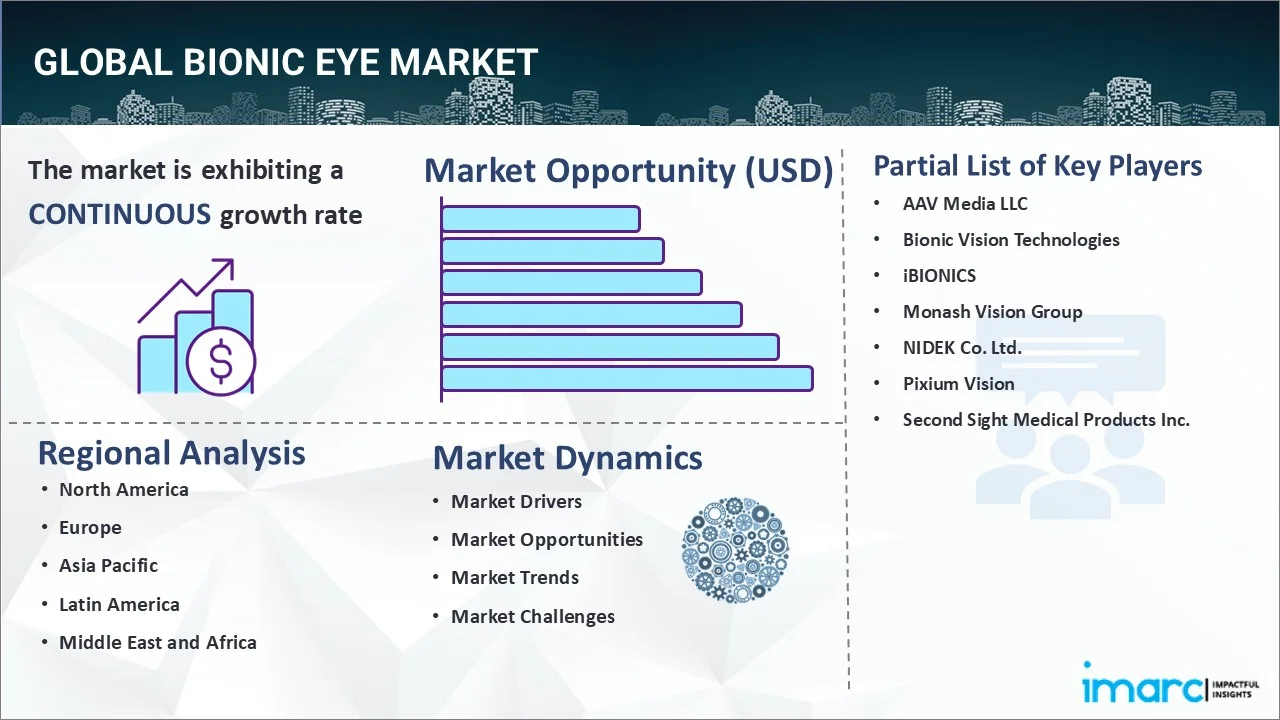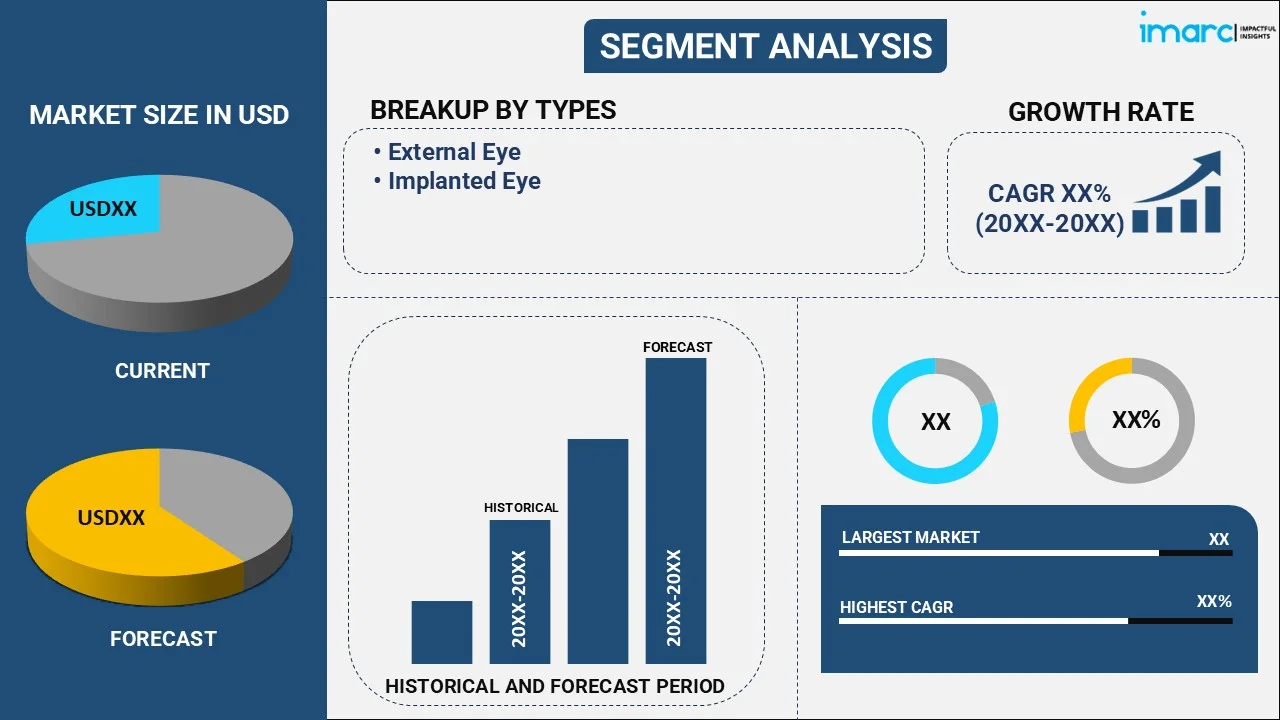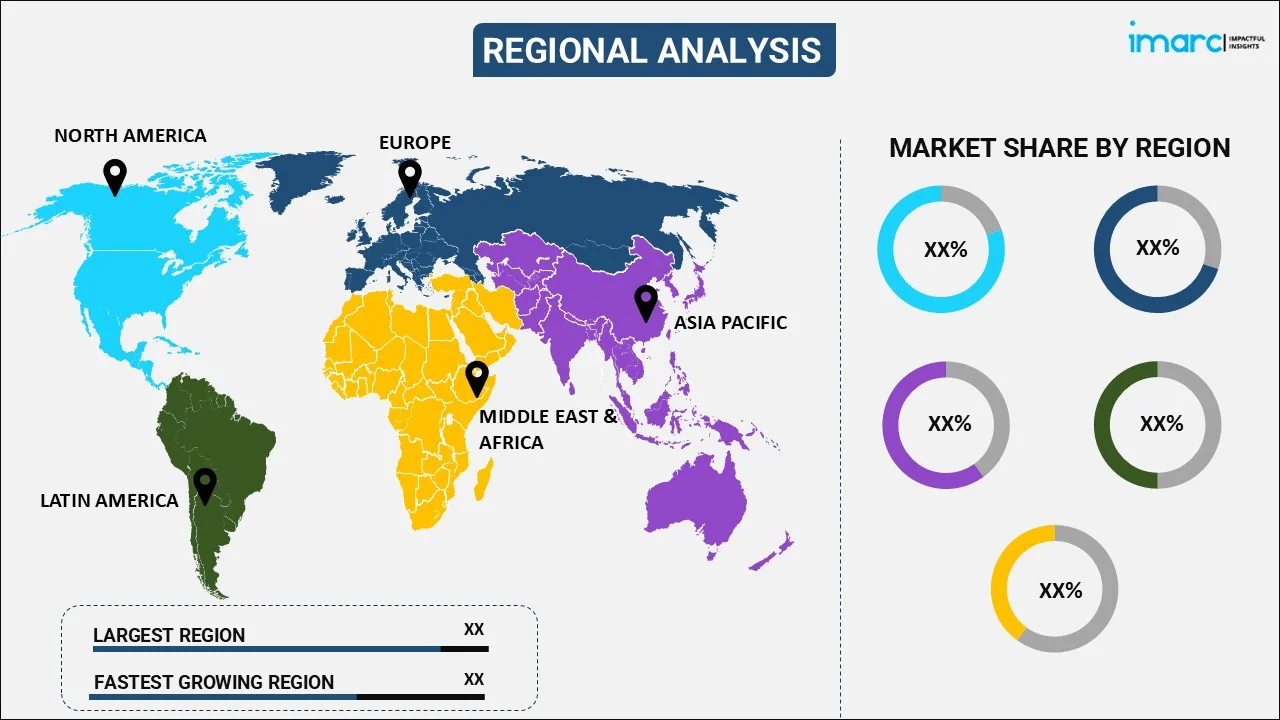
Bionic Eye Market Report by Type (External Eye, Implanted Eye), Technology (Electronic, Mechanical), End User (Hospitals, Ophthalmic Clinics, and Others), and Region 2025-2033
Market Overview:
The global bionic eye market size reached USD 334.8 Million in 2024. Looking forward, IMARC Group expects the market to reach USD 857.2 Million by 2033, exhibiting a growth rate (CAGR) of 10.13% during 2025-2033. The increasing demand for advanced vision restoration solutions, the rising prevalence of visual impairments, and ongoing research, partnerships, and technological advancements are propelling the market.
|
Report Attribute
|
Key Statistics
|
|---|---|
|
Base Year
|
2024
|
|
Forecast Years
|
2025-2033
|
|
Historical Years
|
2019-2024
|
|
Market Size in 2024
|
USD 334.8 Million
|
|
Market Forecast in 2033
|
USD 857.2 Million
|
|
Market Growth Rate 2025-2033
|
10.13% |
Bionic eye is a cutting-edge device that is meticulously crafted, incorporating various components to restore vision. At its core, it consists of an external camera system that captures images, which are then processed by a computer chip. The processed information is transmitted wirelessly to an implanted electrode array, which stimulates the remaining healthy retinal cells or directly activates the optic nerve, bypassing damaged photoreceptor cells. This allows the brain to perceive visual information, albeit in a simplified form. The advantages of a bionic eye are profound, granting individuals the ability to discern shapes, perceive movement, and read large print. Different types of bionic eyes are available, such as retinal implants and optic nerve implants, each tailored to address specific visual impairments.

The global bionic eye market is propelled by the increasing prevalence of visual impairments and blindness due to the aging population and ocular diseases. Besides this, technological advancements in bionic eye implants, such as improved resolution, wireless connectivity, and miniaturization, are fueling the market growth. Additionally, rising investments in research and development (R&D) activities by governments and private organizations are accelerating the innovation and commercialization of bionic eye devices, thus creating a positive outlook for the market. Furthermore, the growing awareness and acceptance of bionic eye solutions among patients, along with the potential to restore partial vision, is boosting the market growth. Besides this, collaborations and partnerships between medical device companies and academic institutions are fostering the development of cutting-edge bionic eye technologies, which, in turn, is supporting the market growth.
Bionic Eye Market Trends/Drivers:
Increasing prevalence of visual impairments and blindness
The surging prevalence of visual impairments and blindness due to the aging population and ocular diseases propels the demand for advanced visual prosthetics. As the global population continues to age, the incidence of age-related eye conditions, such as macular degeneration, diabetic retinopathy, and glaucoma, is on the rise. These conditions often lead to partial or complete vision loss, creating a significant need for effective solutions, such as bionic eye, to provide artificial vision and restore some level of visual function. In line with this, the escalating demand for visual prosthetics is also driving the development and commercialization of bionic eye devices, which, in turn, is acting as a crucial growth-inducing factor.
Technological advancements in bionic eye implants
Rapid technological advancements in bionic eye implants, such as improved resolution, wireless connectivity, and miniaturization, are fueling the market growth. The continuous progress in microelectronics, materials science, and biomedical engineering has led to significant breakthroughs in bionic eye technology. Modern bionic eye implants offer higher resolution and more accurate stimulation of retinal cells, enabling users to perceive shapes, objects, and read large print. These technological advancements not only enhance the effectiveness and usability of bionic eyes but also contribute to the wider acceptance and adoption of these devices among patients and healthcare professionals.
Rising investments in R&D
Burgeoning investments in research and development (R&D) activities by governments and private organizations are accelerating the innovation and commercialization of bionic eye devices. Governments, research institutions, and medical device companies are actively funding studies and clinical trials to improve the functionality and safety of bionic eye implants. Moreover, collaborations between academic institutions, industry players, and healthcare organizations are fostering interdisciplinary research and knowledge sharing. These investments and collaborations are not only driving technological advancements but also expediting the regulatory approvals and commercial availability of bionic eye devices, making them more accessible to patients in need.
Bionic Eye Industry Segmentation:
IMARC Group provides an analysis of the key trends in each segment of the global bionic eye market report, along with forecasts at the global, regional and country levels from 2025-2033. Our report has categorized the market based on type, technology and end user.
Breakup by Type:

- External Eye
- Implanted Eye
External eye is dominating the market
The report has provided a detailed breakup and analysis of the market based on the type. This includes external eye and implanted eye. According to the report, external eye represented the largest segment.
The external eye represents the largest segment due to its associated benefits, such as portability, ease of use, and flexibility, allowing individuals with visual impairments to navigate their surroundings more effectively. They are also less invasive, offering wider potential applicability. In line with this, external eye is used in cases where the eye is completely damaged or missing, or where the neural pathway from the eye to the brain is impaired, making other bionic eye types unfeasible. This potentially includes a larger patient population and a broader range of vision impairments, contributing to its characterization as a growth-inducing factor.
Breakup by Technology:
- Electronic
- Mechanical
Electronic holds the largest share in the market
A detailed breakup and analysis of the market based on technology has also been provided in the report. This includes electronic and mechanical. According to the report, electronic accounted for the largest market share.
Electronic bionic eyes utilize advanced electronic components to restore vision. This, in turn, provides real-time vision and can potentially offer more detailed visual perception as technology advances, thus driving the market growth. Simultaneously, technological advancements are propelling the sector forward. The continued miniaturization of electronic components, advancements in battery technology, and improvements in surgical techniques are leading to the development of more sophisticated, reliable, and user-friendly devices. As a result, the success and acceptability of electronic bionic eyes as a viable treatment option have increased significantly. Governmental and non-governmental organizations' increased financial support for research and development in this field is another substantial market driver. Favorable reimbursement scenarios and regulatory policies also encourage market expansion.
Breakup by End User:
- Hospitals
- Ophthalmic Clinics
- Others
Hospitals hold the largest share in the market
A detailed breakup and analysis of the market based on the end user has also been provided in the report. This includes hospitals, ophthalmic clinics, and others. According to the report, hospitals accounted for the largest market share.
Hospitals play a crucial role in the adoption and implementation of bionic eye technology. These medical institutions serve as centers for specialized procedures, such as the implantation of bionic eyes. With the support of skilled ophthalmologists and advanced surgical facilities, hospitals provide a safe and controlled environment for patients to undergo bionic eye surgeries. Additionally, hospitals offer pre- and post-operative care, including comprehensive assessments and rehabilitation programs, ensuring optimal outcomes for patients with visual impairments.
Breakup by Region:

- North America
- United States
- Canada
- Asia-Pacific
- China
- Japan
- India
- South Korea
- Australia
- Indonesia
- Others
- Europe
- Germany
- France
- United Kingdom
- Italy
- Spain
- Russia
- Others
- Latin America
- Brazil
- Mexico
- Others
- Middle East and Africa
North America exhibits a clear dominance, accounting for the largest bionic eye market share
The report has also provided a comprehensive analysis of all the major regional markets, which include North America (the United States and Canada); Europe (Germany, France, the United Kingdom, Italy, Spain, Russia, and others); Asia Pacific (China, Japan, India, South Korea, Australia, Indonesia, and others); Latin America (Brazil, Mexico, and others); and the Middle East and Africa. According to the report, North America accounted for the largest market share.
North America has a strong healthcare infrastructure, advanced research facilities, and a high level of healthcare expenditure, allowing for the development and adoption of innovative medical technologies. Additionally, the region has a large population of individuals with visual impairments, including age-related macular degeneration and diabetic retinopathy, which creates a significant demand for bionic eye devices. Furthermore, supportive government policies and reimbursement frameworks encourage the use of these advanced prosthetics, making them more accessible to patients.
Competitive Landscape:
The established leaders in the bionic eye market have gained a significant advantage through their extensive research and development efforts, clinical trials, and successful commercialization of their products. These companies have built strong relationships with healthcare providers, hospitals, and ophthalmic clinics, allowing them to establish a solid distribution network. The market is also witnessing collaborations and partnerships between established companies and start-ups, fostering innovation and leveraging synergies. These collaborations aim to accelerate product development, expand market reach, and offer comprehensive solutions for individuals with visual impairments.
The report has provided a comprehensive analysis of the competitive landscape in the market. Detailed profiles of all major companies have also been provided. Some of the key players in the market include:
- AAV Media LLC
- Bionic Vision Technologies
- iBIONICS
- Monash Vision Group
- NIDEK Co. Ltd.
- Pixium Vision
- Second Sight Medical Products Inc.
Recent Developments:
- On February 3, 2023, Nidek Co., Ltd., a leader in the manufacture, design, and distribution of optometric, ophthalmic, and lens edging equipment, formed a partnership with Hoya Vision Care (HOCPF), a leader in optical technology innovation.
- On September 06, 2023, Bionic Vision Technologies (BVT) formed a strategic partnership with Cirtec Medical. Under the partnership, Cirtec has taken a strategic stake in BVT and will assist the Australian company to develop and manufacture its next generation bionic eye.
- On August 20, 2022, Second Sight Medical Products, Inc., a leading developer of implantable visual prosthetics, announced the completion of its merger with Nano Precision Medical, Inc. (“NPM”).
Bionic Eye Market Report Scope:
| Report Features | Details |
|---|---|
| Base Year of the Analysis | 2024 |
| Historical Period | 2019-2024 |
| Forecast Period | 2025-2033 |
| Units | Million USD |
| Scope of the Report | Exploration of Historical and Forecast Trends, Industry Catalysts and Challenges, Segment-Wise Historical and Predictive Market Assessment:
|
| Types Covered | External Eye, Implanted Eye |
| Technologies Covered | Electronic, Mechanical |
| End Users Covered | Hospitals, Ophthalmic Clinics, Others |
| Regions Covered | Asia Pacific, Europe, North America, Latin America, Middle East and Africa |
| Countries Covered | United States, Canada, Germany, France, United Kingdom, Italy, Spain, Russia, China, Japan, India, South Korea, Australia, Indonesia, Brazil, Mexico |
| Companies Covered | AAV Media LLC, Bionic Vision Technologies, iBIONICS, Monash Vision Group, NIDEK Co. Ltd., Pixium Vision and Second Sight Medical Products Inc. |
| Customization Scope | 10% Free Customization |
| Post-Sale Analyst Support | 10-12 Weeks |
| Delivery Format | PDF and Excel through Email (We can also provide the editable version of the report in PPT/Word format on special request) |
Key Benefits for Stakeholders:
- IMARC’s report offers a comprehensive quantitative analysis of various market segments, historical and current market trends, market forecasts, and dynamics of the bionic eye market from 2019-2033.
- The research study provides the latest information on the market drivers, challenges, and opportunities in the global bionic eye market.
- The study maps the leading, as well as the fastest-growing, regional markets. It further enables stakeholders to identify the key country-level markets within each region.
- Porter's five forces analysis assist stakeholders in assessing the impact of new entrants, competitive rivalry, supplier power, buyer power, and the threat of substitution. It helps stakeholders to analyze the level of competition within the bionic eye industry and its attractiveness.
- Competitive landscape allows stakeholders to understand their competitive environment and provides an insight into the current positions of key players in the market.
Key Questions Answered in This Report
The bionic eye market was valued at USD 334.8 Million in 2024.
We expect the global bionic eye market to exhibit a CAGR of 10.13% during 2025-2033.
The rising prevalence of macular degeneration and other eye-related disorders, along with the growing consumer awareness regarding the available treatment alternatives for complete or partial blindness, is primarily driving the global bionic eye market.
The sudden outbreak of the COVID-19 pandemic had led to the postponement of elective bionic eye treatment procedures to reduce the risk of the coronavirus infection upon hospital visits and interaction with medical equipment or healthcare professionals.
Based on the type, the global bionic eye market can be categorized into external eye and implanted eye. Currently, external eye accounts for the majority of the global market share.
Based on the technology, the global bionic eye market has been segregated into electronic and mechanical, where electronic currently holds the largest market share.
Based on the end user, the global bionic eye market can be bifurcated into hospitals, ophthalmic clinics, and others. Currently, hospitals exhibit a clear dominance in the market.
On a regional level, the market has been classified into North America, Asia-Pacific, Europe, Latin America, and Middle East and Africa, where North America currently dominates the global market.
Some of the major players in the global bionic eye market include AAV Media LLC, Bionic Vision Technologies, iBIONICS, Monash Vision Group, NIDEK Co. Ltd., Pixium Vision, and Second Sight Medical Products Inc.
Need more help?
- Speak to our experienced analysts for insights on the current market scenarios.
- Include additional segments and countries to customize the report as per your requirement.
- Gain an unparalleled competitive advantage in your domain by understanding how to utilize the report and positively impacting your operations and revenue.
- For further assistance, please connect with our analysts.
 Inquire Before Buying
Inquire Before Buying
 Speak to an Analyst
Speak to an Analyst
 Request Brochure
Request Brochure
 Request Customization
Request Customization




.webp)




.webp)












